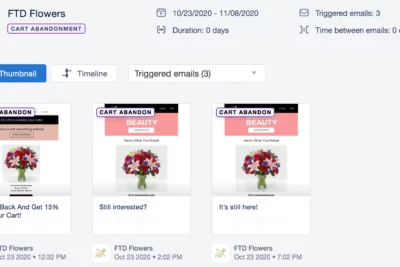When companies and retailers assess how to reach their customers, they often think of traditional channels like email, direct mail, and social media. All of these avenues have an important place in your marketing toolkit, but there’s one other, often overlooked, channel that can drive substantial results—SMS marketing.
With SMS open rates as high as 98 percent, and 60 percent of consumers reading a text within just five minutes of receiving it, sending texts to your customers has proven to be a powerful way to drive direct sales.
However, despite more than half of customers preferring to receive promotions via text message, only 11 percent of businesses actually send promotions via SMS.
There’s a clear opportunity for brands to strengthen their customer experience and unlock new sales through texts. To help you take advantage of this potential, let’s explore how to create a text subscription service and the common types of text subscription messages you can send.
What is a text subscription service?
A text subscription service enables your brand to send text messages directly to your customers or users. In an ideal setup, your customers can proactively message your brand back, too.
Sending SMS messages to your customers can fulfill a variety of marketing or transactional needs, from driving sales to improving the customer experience. But you need to carefully balance how often you reach out to customers and what value you provide through your text messages. In short, give people a reason to look forward to messages from your brand.
How does a text subscription service work?
The elements of managing a text subscription service are very similar to those of an email marketing program: Get customers to sign up, plan your outreach, measure your results to fine-tune your strategy, and keep your customer list clean.
The first step in starting a text message subscription service is to grow your SMS list. After all, messaging an empty contact list is a recipe for a one-way conversation.
Remember: You need to gain explicit permission from your customers for you to send them text messages, just like when engaging them with email marketing.
Build your SMS list by leaning on your existing brand channels. Announce that customers can now receive text messages from your brand, and explain some of the reasons you may text them. A few places you should promote your SMS service for customers are:
- In-store checkout forms
- Popups and sticky bars on your website
- Social media channels
- Email newsletters
One way to drive sign-ups is to provide a unique perk for customers to enroll. A special one-time discount for opting in is often all you need to get people to join. Then, it’s up to you to provide ongoing value to your customers through your text messages.
Your text message subscription list will likely start small, which is OK! Use your initial list to get familiar with sending text messages and refine your approach.
How does a text message subscription strategy help you?
Text messages are highly effective because they reach customers no matter where they are. They’re virtually guaranteed to reach their final destination—unlike an email that may get routed to a spam folder—and can be sent in mass volumes effortlessly.
As you think through potential ways that your brand can engage customers through text, consider valuable customer text message use cases like the following:
Abandoned cart

Sometimes customers eagerly visit your site to fill up their cart, but then life gets in the way and they accidentally close the page before they can finish shopping. Sending a single abandoned cart text message within 48 hours could help customers pick up where they left off and finish their purchase. Use these messages sparingly, though. Stick to just one message per cart or one message within a specific time period.
Appointments or bookings
Text messages are helpful to manage appointments with customers. Use them to confirm an appointment, send reminder messages, or offer to reschedule. In fact, 83 percent of customers say they want to receive text message appointment reminders. These text messages can help you reduce your last-minute cancellations or no-shows, and they help your customers have a better experience with your brand.
Loyalty club offers

Your most loyal shoppers will likely sign up to receive text messages from your brand. You should reward them for doing so! Send regular offers and discounts that are exclusive to your loyalty club members. Loyalty club text messages like this one from Staples reinforce the value of your membership club and strengthen your connection with each customer.
Share news and updates

Keep customers in the loop on your latest news and updates through text messages. Ensure that everything you send has a direct customer benefit. What do you want them to learn, and how will this information help them in their day-to-day or validate their reason for shopping with your brand? New product launches, regional store openings, or contest announcements are just a few examples of updates you may send.
SMS surveys
Brands thrive on direct customer feedback. Are your customers happy with the service you provide? Was their last experience with your brand great? Would they recommend you to a friend?
SMS surveys provide an opportunity to solicit candid customer feedback so you can improve your strategy and ensure you’re meeting your customers’ needs. If customers feel like they don’t have a way to voice their concerns, they will likely turn to social media or review sites like Yelp—which can damage your brand reputation if that feedback is especially pointed (and something you could have easily avoided).
Tracking updates
We’ve all eagerly waited for an item to arrive after we purchased it—sometimes checking multiple times daily for shipping updates. SMS text messaging can provide customers with shipping updates so that they don’t have to proactively search for this information. Sending these updates shows that you’re excited for them, too, and are eager to provide updates as they wait for their items to arrive.
Tips to create a text subscription service
Just because text messages have high open rates doesn’t mean they’re guaranteed to drive sales or strengthen customer loyalty. If you send too many text messages or send off-brand messages, you could tarnish your brand reputation and cause customers to opt out from your texts.
When creating a text subscription service plan and drafting your messages, keep the following tips in mind:
Segment your audience
The best way to lead a successful text subscription strategy is to reach out to customers with personalized offers on their terms. Segment your subscribers based on their shopping behavior, how they’ve engaged with your past text messages, and their demographics, including location. Create specific customer lists so you can easily customize the texts sent to each group.
Prioritize short code texting
Unlike traditional, long code phone numbers, a short code is a unique phone number that is designed for sending high volumes of messages. If you send hundreds of messages daily from a traditional phone number, your messages may be marked as spam. Long code messages also take longer to send, as carriers usually limit long code sending to just one message per second. Short code numbers are approved for high-volume sending, making them perfect for your marketing and promotional text messages.
Keep messages short
A standard text or SMS message is typically 160 characters or less. Customers may incur charges for receiving text messages, and some have character limits for individual messages. Keep your text messages short so that everything delivers as just one text message, reducing the potential cost for your customer.
Only text during typical working hours
It’s crucial that you reach out to customers during normal business hours, which is why you need to segment your text message subscription lists by location or time zone. If you text a customer late at night you may wake them up, which will likely frustrate them and cause them to opt out of your messages.
Make opting out easy
Add an unsubscribe link to all of your customer text messages to make opting out simple. Consider sending an email to confirm that the customer has opted out of text messages and try to understand why they unsubscribed. These subscription cancellation examples for email can help you find the best way to word your message.
Send coupons and deals
Most customers sign up for text messages in hopes that they will receive coupons and deals. Keep the majority of your messages focused on promoting sales and offering exclusive discounts for text subscribers. Use unique tracking links or discount codes so you can directly measure how many sales resulted from your text efforts.
Manage subscriptions with an SMS marketing platform
Managing all of your customer data to send highly personalized and timely texts is difficult without a tool to help. We recommend that you adopt an SMS marketing platform to better manage your text message subscription campaigns and benefit from automation features that make the process a breeze.
When choosing an SMS marketing platform, you should ask which regions are covered by the provider, the cost per message, whether customers can text back, and what level of support is provided. You’ll want a solution that fits your budget but also gives you the capabilities you need—and can integrate with your other marketing technology.
How to know if your text subscription service is successful
Investing in any marketing channel means you’ll need to prove its ROI. With text subscription services, there are a few different ways to know if your program is successful. We recommend you track these SMS marketing KPIs:
- Delivery rate: How many messages were successfully delivered?
- Click-through rate: Did people click on links in your text messages?
- Conversion rate: Were sales made because of your text messages?
- Earnings per message: What is your total sales from text divided by the number of messages sent?
- Cost per subscriber: What are your total sales from text divided by your total number of subscribers?
- Total subscriber count: How many people have opted in to receive your text messages?
- Response rate: Have customers proactively messaged your brand? Are those messages positive or negative?
- Unsubscribe rate: How many people have opted out of your text message?
Deliver ongoing customer value through text
There are many reasons why brands should create a text subscription service, and a well-managed SMS strategy can be transformational for your customer experience.
Test different message types and closely monitor KPIs like responses and direct sales to see what types of messages work best. If you can, ask your customers directly what type of text messages they’d like to receive from your brand or ways that you can improve their experience.
Lastly, to help you boost the success of your text subscription service, sign up for MailCharts to discover SMS campaign examples and get inspired!



